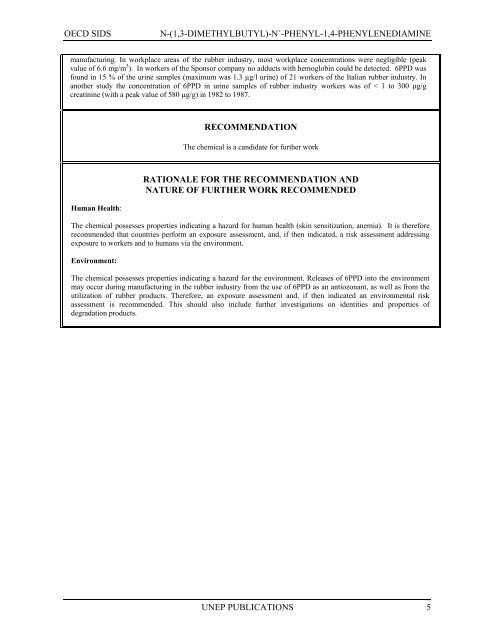N-(1,3-Dimethylbutyl)-N
N-(1,3-Dimethylbutyl)-N
N-(1,3-Dimethylbutyl)-N
You also want an ePaper? Increase the reach of your titles
YUMPU automatically turns print PDFs into web optimized ePapers that Google loves.
OECD SIDS<br />
N-(1,3-DIMETHYLBUTYL)-N´-PHENYL-1,4-PHENYLENEDIAMINE<br />
manufacturing. In workplace areas of the rubber industry, most workplace concentrations were negligible (peak<br />
value of 6.6 mg/m 3 ). In workers of the Sponsor company no adducts with hemoglobin could be detected. 6PPD was<br />
found in 15 % of the urine samples (maximum was 1.3 µg/l urine) of 21 workers of the Italian rubber industry. In<br />
another study the concentration of 6PPD in urine samples of rubber industry workers was of < 1 to 300 µg/g<br />
creatinine (with a peak value of 580 µg/g) in 1982 to 1987.<br />
RECOMMENDATION<br />
The chemical is a candidate for further work<br />
Human Health:<br />
RATIONALE FOR THE RECOMMENDATION AND<br />
NATURE OF FURTHER WORK RECOMMENDED<br />
The chemical possesses properties indicating a hazard for human health (skin sensitization, anemia). It is therefore<br />
recommended that countries perform an exposure assessment, and, if then indicated, a risk assessment addressing<br />
exposure to workers and to humans via the environment.<br />
Environment:<br />
The chemical possesses properties indicating a hazard for the environment. Releases of 6PPD into the environment<br />
may occur during manufacturing in the rubber industry from the use of 6PPD as an antiozonant, as well as from the<br />
utilization of rubber products. Therefore, an exposure assessment and, if then indicated an environmental risk<br />
assessment is recommended. This should also include further investigations on identities and properties of<br />
degradation products.<br />
UNEP PUBLICATIONS 5
















